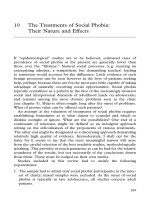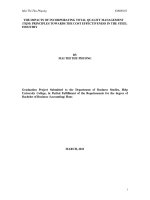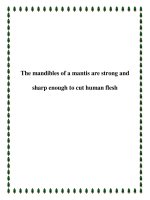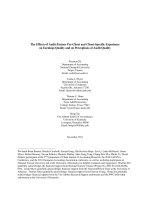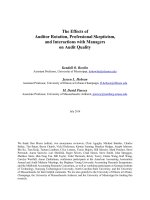THE STRATEGY OF EFFECTIVE PRODUCTION QUALITY MANAGEMENT AND PROJECT INVESTMENT TO 2020 AT SUFAT VIETNAM CORPORATION
Bạn đang xem bản rút gọn của tài liệu. Xem và tải ngay bản đầy đủ của tài liệu tại đây (1.27 MB, 75 trang )
Paris Graduate School of Management
Thai Nguyen University
INTERNATIONAL EXECUTIVE
MASTER OF BUSINESS ADMINISTRATION PROGRAM
THESIS TITLE
THE STRATEGY OF EFFECTIVE PRODUCTION & QUALITY
MANAGEMENT AND PROJECT INVESTMENT TO 2020 AT SUFAT
VIETNAM CORPORATION
FOCUS ON
THE PRODUCTION STRATEGY FOR SUFAT VIETNAM
CORPORATION 2013-2017
Student’s name:
DINH AN
Intake I
October, 2012
Final Thesis – Dinh An
ABBREVIATIONS
No Abbreviate
Meaning
1
SXKD
Business
2
DN
Enterprise
3
SXLR
Production and Assembly
4
ISO 9001:2000
Quality Management based on ISO
5
P.KCS
Quality Control Department
P.Vật tư
Material Department
6
PX. Gia công
Producing workshop
7
BGĐ
Ban Giám đốc
8
KCN
Industrial zone
9
SX
Production
10
R&D
Reaserch and developing
11
SP
Product
12
CBCNV
Employees
13
BLĐ
Leader ship
14
NSNN
Government budget
15
CLSP
Product quality
16
FDI
Foreign Investment
17
NĐH
Localization
18
NCC
Supplier
19
TNHH
Limited liability company
20
21
22
1
Final Thesis – Dinh An
FOREWORD
1. Thesis origin
After more than five years of joining the WTO (01/11/2007) Vietnam's
economy in general, Vietnamese enterprises in particular have moved and
achieved remarkable initial achievement. Economic growth in 2009 reached 5.2%
(estimated 7-7.5%); 2010 was 6.78% (expected 6.5%); 2011 is 5.89% and
Vietnam stands in top 5 countries in the world with high growth rate.
(Source: />
In that Vietnam's total industrial output increased steadily over the years (see
Appendix 1). In 2010 it increased 14%, exceeding the previous forecast of 12%.
But that's not the signs of sustainable growth. Competitiveness of Vietnamese
goods in three class: country, sector and enterprise is less, in that their cost
remains high, low compared to international standards, service quality and lack of
professionalism. Impact consecutive world economic crisis of 2007, 2009 plus
inflation lasts and high credit interest rates in the country pushed Vietnamese
businesses in danger of closing.
It is on a general level.
On the particular level, the Vietnamese motorcycle industry was formed, in
development for more than 10 years and specially rapid development in the period
2001-2005. Apart from four Motorcycle manufacturers (first foreign-invested,
developed in the 1990s) is VMEP (1984), Honda, Yamaha, Suzuki (1986), there
were more firms both FDI and local participated in the industry.
Through many years , the overall picture of the industry now show a clear
negative signal that since 2008 almost all of the domestic motorcycle market share
by FDI enterprises dominate.
2
Final Thesis – Dinh An
VIETNAM MOTORBIKE MARKET SHARE
(2008-2010)
79%
80%
66%
60%
44%
40%
29%
27%
20%
20%
14.3%
15%
6%
0%
2008
DN trong nước
2009
FDI
2010
Nhập khẩu
Among the more than 10 domestic enterprises and "left", SUFAT VIETNAM
Company facing an intractable problem: What need to do to be able to "live"
under strong competitive pressure from FDI? Continue to exist for the
development or preservation and withdrew from an industry where product cycles
in the recession? If they stayed, how to overcome challenges to the survival and
sustainable development, and what is the core competitiveness of enterprises? ...
Answer the question comes from hardness practices, a comprehensive
development strategy, creative and feasible for the companies in the industry in
general, Company SUFAT VIETNAM particular can be applied in practice within
5 years is essential. Besides the functions strategies of Marketing, Finance ...,
"Production Strategy for SUFAT Company Vietnam for the period 20132017" played a very important role. The analysis in the next chapter (the thesis
content) will show Production-Operations is one of the core value chain create
competitive advantages of the SUFAT VIET NAM company.
2. Thesis objects
1) Introduce all the resources involved in production activities in enterprises,
systematic chain of operations by operated schemes; working process;
statistics tables or operating notes…
3
Final Thesis – Dinh An
2) To analyze the state of all production activities of SUFAT VIET NAM
Company at both view points: inside of enterprise and motorcycle production
sector in Vietnam, thereby making the review and evaluation of these
problems exist, the objective and subjective reasons; their effects ...
3) On the basis of the above analysis, make recommendations; choose the best
Production-Operations strategy with specific objectives and synchronization
solutions in the implementation of the business.
3. Research Methodology
The way to approach and solve the problems of the thesis is briefly described
in the following scheme:
INFORMATION COLLECTION
OUTSIDE:
- Secondary information: from
newspapers, internet…
- Primary Information: market
surveys; interview agents and
consumers; insider sources…
INSIDE:
- Primary Information: from Company
documents and books source; minutes
of meetings; opinions, internally
discusions; lessons learned from the
past…
ANALYSIS:
- Working group discussions.
- Removes noise or unreliable information,
processed by statistical methods, synthetic
analysis to evaluate and draw conclusions.
ISSUES PROPOSAL
- Working group discussions
- Given the strengths, weaknesses, opportunities
and threats.
PROPOSED STRATEGIES
- Working group discussions.
- Provide strategies to consider and choose.
4
Final Thesis – Dinh An
4. Thesis contents
The main content of the thesis in chapter 03:
-
Chapter I:
RATIONALE
-
Chapter II:
ANALYSIS PRODUCTION SITUATION OF SUFAT
VIETNAM COMPANY.
-
ChapterIII: PRODUCTION STRATEGY FOR
COMPANY PERIOD 2013 to 2017.
5
SUFAT VIETNAM
Final Thesis – Dinh An
Chapter I:
1.1
RATIONALE
The basic theory of strategy
1.1.1 Definition
"Strategy is the direction and scope of an organization over the long term: a
strategy will bring advantage for the organization through the optimal placement
of resources in a competitive environment in order to meet market demand and
expectations of the contribution of capital ”...
(Source: )
According to the traditional approach, the business strategy can be viewed as
the long-term plan of an organization in order to achieve to long-term goals.
Management history researcher, Alfred D. Chandler said that "strategy is the
determination of the basic long-term objectives of a business and the
implementation of the program working in conjunction with the allocation of
resources necessary to achieve those goals." As such, following his ideas strategy
clearly is a planning process with wisdom, in which firms choose their own goals
and determine action plans to accomplish those goals best and seek to allocate
resources accordingly. Traditional approach has the advantage that makes it easy
for businesses to figure out the need for strategic planning and see the benefits of
the strategic aspects of long-term planning. However, in a volatile business
environment of today, the limitations of the traditional approach is that it does not
have the ability to adapt flexibly to changing business environment.
With the current approach, the strategy may be larger than what the business
intends to plan or to implement. According to the concept of Mintzberg, strategy
is a model of the flow of decisions and action plans. This model can be any type
of strategy: pre-designed strategy or mutations strategy. Modern approach makes
it easy for businesses to respond flexibly to changes in the business environment
and promote the creativity of the enterprise’s members. However, it requires
leadership, management must have the ability to predict the conditions for
implementation of the strategy and assess the value of the mutation strategy.
6
Final Thesis – Dinh An
Through the above approach, we can understand that: the business strategy of
a business is the art of building long-term goals and the policies implementing
aimed at orientation and create competitive advantage of enterprises.
Characteristics of a firm's business strategy:
- The long-term orientation: business strategy set goals and determine the
direction of development of the business in the long term (3 years, 5 years, 10
years) to orient in a business activityvolatile business.
- The goal: business strategy often define the basic objectives, the business
orientation of each enterprise in each period and the policy in order to comply
with the objectives set out.
- Relevance: this requires enterprises when building business strategies need to
assess the true state of their business activities. At the same time must be regularly
reviewed and adjusted to suit the changes of the environment.
- Continuity: business strategy must be reflected during continuous from the
elaboration, implementation, assessment of strategic adjustment.
- Business strategy in today's conditions can not be separated from the
competition because of a business strategy to ensure business competitiveness in
the market. In the current process of globalization, the business operations are
connected all over the world make up the influence and interdependence. Since
then has created fierce competition among enterprises in the same sector as well
as between sectors in the economy.
1.1.2 The process of strategy formulation
Enviroment
Ânalysic
Strateric
issues
Opportunity
/Threats
Strateric
goals
setting
(Source: Dr. Vũ Thành Hưng Strategy
Implement
Strategy
Assessment
Deputy Director of the
Institute of Business
Administration, from the
Enterprise
Analysisc
University of National
Strength/
Weakness
Economics ...)
Strategy Control
7
Final Thesis – Dinh An
"Strategies need more than
just a dream. A good
strategy needs information
from many source and
analysis them. It also takes
the right decision ... "
(Source: Thomas E. AmblerStrateric Issues)
1.1.3 The tools to analyze, evaluate and select strategies
1. PEST:
Used to analyze and evaluate the impact
of the external environment (macro
environment) to the business operations
of the enterprise.
2. PORTER’S FIVE FORCES
Used to analyze and evaluate the impact
of the external environment (industry
environment) to the business operations
of the enterprise.
(Source: Michael-Porter, Harvard Business
Review, 1979)
3. EFE (Internal Factors Enviroment)
8
Final Thesis – Dinh An
Used
to
assess
the
impact
of
environmental factors external to the
business operations of the enterprise.
4. IFE (Internal Factors Enviroment)
Used to assess the impact of these
factors within the internal business
operations of the enterprise.
5. 7M & I
Used to analyze and evaluate the
(Man; Material; Money; Machine;
resources and capacity of the
Method; Management; Moral Value
and Informations)
department within the enterprise.
(Source: />are the 7m and-i-of management)
5. SWOT
Used to aggregate summary of the
strengths and weaknesses within the
enterprise, external opportunities and
challenges for businesses.
6. TOWS
Used to suggest combination strategies
for business :
- SO Strategy: use strengths to exploit
opportunities.
- ST Strategy: use strengths to avoid the
risk.
WO Strategies: limited weaknesses to
exploit the opportunity.
9
Final Thesis – Dinh An
- WT strategy: limit the weaknesses to
minimize the risk.
7. SPACE (Strategic Position Action Used to guide the strategy for the whole
Evaluation)
company. SPACE matrix using 04
measuring elements are:
- The financial strength of the business.
- The attractiveness of the industry.
-
The
stability
of
the
external
environment.
- The competitive advantage of the
business.
8. QSPM (Quantitative Strategic
Planning Matrix)
Used to quantify the feasibility of each
of the strategies proposed in order to
find the priority one should be done:
- The main external factor.
- The main internal factor.
1.2
Production Strategy
1.2.1 Concept
According to Dr. Alfred Sarkissian:
"Production or operational strategy is a set of decisions or reasons for the action
necessary that an organizations need to enforce to produce goods and services.
Production strategy showing that the operational functions of the business should
be given, the productive resources should be selected, deployed and controlled. "
Types of Production Operations strategy can be focused on the following
objectives:
10
Final Thesis – Dinh An
1) Quality: The quality of the goods and services provided must be consistent with
the standards and meet customer requirements. Quality can be achieved through a
highly skilled labor force, appropriate technology and effective use of quality
standards.
2) Speed: This strategy requires the provision of goods and services as fast as
customers would want. Speed can be achieved by reserves of raw materials,
supply of materials quickly and effectively control the flow of work
3) Reliability: Ensure on time or delivery schedule promised to customers. It is
achieved by planning SX science, machinery and equipment reliability and the
commitment of the employees.
4) Flexibility: Involves able to respond to changes in product design, order size
and delivery time requested.
5) Cost: Cost efficiency is achieved by using a reasonable capacity, reduce the
cost, multifunction devices and increase productivity.
1.2.2 Some modern models of Production Management
ISO 9001
ISO 9001 is a quality management system that, including the specialized
quality management standards for specific industries. This is a system of
organizational structure, processes, responsibilities and resources are clearly
identified and used to evaluate the overall quality management efforts. ISO 9001
certification ensures the company's customers that systems and procedures
acceptable minimum is applied in the Company to ensure that minimum quality
standards are met.
Lean Manufacturing
Is a system of tools and methods to eliminate waste and inefficiency in the
production process to reduce production costs thereby improving competitiveness.
The goal of LEAN include:
11
Final Thesis – Dinh An
1. Waste reduction and waste.
2. Reduce production cycle.
3. Reduce inventory levels.
4. Labor productivity growth
5. Utilization of equipment and
space.
6. Increased flexibility.
7. Increased productivity
So LEAN system aims to reduce the time from order to production process
and product distribution by eliminating activities do not bring value (non-value
added) and the wastecosts in the production process. Model ideal that LEAN
system aiming to one-piece flow (one-piece flow) is governed by customer
demand and a manufacturer applies Lean, continuous improvement toward the
ideal model.
6 Sigma (6σ):
In the early 1980s, in an effort to enhance the highest quality for its products,
the U.S.Company Motorola has initiated strict management model of the
production process and begin to introduce the concept of 6 Sigma. The success of
this management model in Motorola has created a movement widely deployed in a
wide range of leading companies such as IBM, DEC, Allied Signal, GE, etc. So
far, this model not only been widely in the manufacturing sector but also in the
service sector with how tightly controlled the stage, the process provides the
model of 6 Sigma. Many companies have been successfully deployed such as
Bombardier, Raytheon, Siemens, Nokia, Navistar, Wipro, Kodak, Sony, Siebe,
3M, Polaroid, Citibank, ABB, Dupont, Lomega, Amex, Seagate , Black & Decker.
Summary of this model are as follows:
-
Improved performance of the process: event-based to address serious
quality issues with customers (Customer Critical to Quality CTQ);
12
Final Thesis – Dinh An
-
Improved customer satisfaction: increased responsibilities to customers,
reduce customer dissatisfaction;
-
Reduce costs: Reduce errors in product, service and delivery time, increase
efficiency, reduce waste.
Highlights of 6-Sigma model is the use of statistical techniques to control the
production process or service provider. The process is designed to achieve the
transformation is determined through statistical techniques, analysis of the factors
causing the errors and trying to adjust to the process of achieving identified goals.
The integrated model Lean-6 Sigma
It’s clearly that, to create products with the least cost, fastest delivery time, the
Lean model (Lean manufacturing) will help businesses increasing their
competitiveness and increase profitability. However, quality aspects of the
product / service is still a concerned matter. Reality experience in a number of
enterprises in Vietnam shows the variation (heterogeneity) on product quality in
the manufacturing process / service still requires better control measures. Some
businesses with good support thanks to modern technology (eg automation), may
overcome this problem better, but still need to control the process. Therefore,
combined with 6 Sigma model can help give your business a strict process control
methods, thereby stabilizing and reducing the variation in the quality of products /
services provided.
Compare characteristics of two models Lean and 6 Sigma
LEAN
6 SIGMA
13
Final Thesis – Dinh An
Speed
Minimize waste.
Demonstrate activities value chain.
Materials management at the right time.
Intuitive Management.
Efficient Equipment.
Works to improve recommendations
Standardized operations.
5S, PDCA
Reduce variation.
High quality to meet customer.
Prevent failure.
RTY, COPQ.
Stable statistical nature.
The process can be predicted.
DMAIC.
Teamwork.
Design by 6 Sigma
The same:
- The same emphasis on process, Lean focuses on increasing the speed of the
process to minimize waste, 6 Sigma focuses on process to minimize variation;
-
Along emphasized minimizing costs. Lean cost of all waste. 6 Sigma to
reduce costs through project COPQ (cost of poor quality);
-
Along promote the participation of people. Lean with Kaizen activities and
recommendations. 6 Sigma with project team 6.
Different:
- Lean: speed and waste; 6 Sigma: change and defect evaluation process;
- Use different tools. Lean: identify value chain activities, time, visual
management, PDCA, standardize work. 6 Sigma: statistical process capability, the
sample design, the cost of quality, DMAIC, ...
- Lean: use the technical approach and efficient use of industrial equipment in
general; 6 Sigma: use of statistical evaluation, analysis of variation and statistical
optimization.
Two these models combined together will form a very effective management
strategies. One to reduce management costs, the other to improve the quality and
reduce process variation of the product / service provided. For each model, tools,
specific techniques will need to be selected to work together, as well as in
accordance with the actual conditions of the business. The ultimate goal is to help
businesses meet the requirements of the customers in the best way, the most
effective.
(Source: www.saga.vn)
14
Final Thesis – Dinh An
Chapter II:
ANALYSIS
PRODUCTION
SITUATION
OF
SUFAT
VIETNAM
COMPANY.
2.1 Company Introduce
2.1.1 Summary:
Company Name :
CÔNG TY TNHH SUFAT VIET NAM
Address :
Industrial Pa rk Pho Noi B, Hung yen Province
Type:
Private Company
Estaplishment year:
1996
Number of employees:
300 persons
Average revenue of the 3 recent years (mil VND):
Business areas :
Factory: Industrial Park
PhoNoi B, HungYen
300,000 mil VND/year
Motorcycle Manufacturing
Model 2010: Sufat Fivemost
Processing Workshop
2.1.2 The process of formation and development:
1996-1999 :
On 8th Agust, 1996 as the date established businesses with the first name is:
Company Name: PHAM TU. CO., LTD
Office: 248B Tay Son Dong Da District, Hanoi.
Registered business lines: capital goods, consumer trade (mostly motorcycles).
Charter capital: 100 million VND.
1996: Company's operations mainly in the business of old motorcycle (second
hand) imported from Japan. Sales reached 6000 units / year, mainly wholesale.
15
Final Thesis – Dinh An
1997-1998: Vietnamese Government begins banned old motorcycle, the
company moved to import the new vehicles (mainly Wave style motorcycle from
Thailand and then to Laos in the form of barter). This stage sales reached 11,000
units/year.
1998-1999: Motorcycle China entering the Vietnamese market, PHAM TU.
CO., LTD makes a joint venture with a number of domestic companies which
have quota to import motorcycle components (primarily China) assembled in
Vietnam.
In late 1999, the idea of strategic shift from mere business to invest in
production appear in the launch of the project team for the Board of Directors
with the task of setting up viable projects for investment to lease land,
construction of buildings, procurement of machinery and equipment, invite
experts to prepare a plant to produce, assembly motorcycle .
2000 - 2001:
15 November, 2000 Project "Vietnam-China factory producing and assembly
motorbike engines parts” PHAM TU Co.,Ltd. as investors approved by Hung Yen
People's Committee.
Location: PhoNoi B Hung Yen province.
The total lease area: 44 685 m2.
Lease term: 35 years.
Total initial investment: 74 billion and 255 million VND
Start a period to implement both phase together: factory construction and
motocycle production. One hand have to assembly many motorcycles to promote
business, consumption in order to get money for investment back to the plant, on
the other hand have to quickly complete construction categories: infrastructure,
electricity, water, ground workshop. In late 2001, the first workshops of the
factory is: workshops motorized, car assembly, welding, painting activities.
2002 - 2005:
16
Final Thesis – Dinh An
After a long process of development, the enterprise has grown constantly in size
and production capacity. SUFAT brand has initially been confirmed in the
marketplace associated with product quality reputation. Some of the following
changes:
Business name: SUFAT VIET NAM Company
Office: PhoNoi B Hung Yen province.
Total investment: 167 billion VND
Lines of business registration:
-
Produce detailed engine and motorcycle parts.
-
Assemble engine motorcycle.
-
Installation of motorcycle.
-
Trading of consumer materials (mostly motorcycles).
-
Manufacture of automotive parts, automotive engine assembly, automotive
assembly types.
Charter capital: 106 billion VND.
2006 until now:
SUFATVIETNAM CO. started building Vietnamese motorcycle brand, some
new products such as the Backhand (2005); Retot (2006); Labour (2008 on the
occasion of the Company was awarded the Labor medal); Thousand (2010-1000th
anniversary of Thang Long-Hanoi); XV-125 (2011)…have brought SUFAT
brands becoming closer to consumers, and created fierce competition with other
famous brandsmarket.
2.2 Analysis of factors within the enterprise.
2.2.1 Analysis and assessment of resources in the enterprise (7M)
(7M: man; material; machine; money; method; management; maral value and
informations)
Tangible resources:
1) Finance:
17
Final Thesis – Dinh An
Table 2.2.1a
SYNTHETIC DATA
Characters
2011
2010
2009
Asset
259
229
204
Equity
152
125
125
Gross Profit (EBIT)
22
21.6
15
2
0.04
7
8.5
5
135
130
120
2011
2010
2009
MP: Net income / Revenue
5.39%
6.59%
4.16%
BEP: Gross Profit / Asset
8.5%
9.4%
7.4%
ROA: Net income / Asset
3%
4%
2.5%
Net profit from business
activities
Net income (NI)
Revenue (TR)
SYNTHETIC CRITERIA
Criterias
Here:
Margin Profit MP = NI/TR
BEP = EBIT /Asset
ROA = Net income / Asset
ROE = Net income / Total common shares
Chart 2.2.1c
10.00%
8.00%
6.00%
MP
BEP
4.00%
ROA
2.00%
0.00%
2009
2010
2011
(Source: Company Data –July, 2012)
18
Final Thesis – Dinh An
Remark:
All the criterias MP, BEP and ROA are low, compared with the norm of the
corresponding sector is 12%; 16% and 8%, it shows that SUFAT VIETNAM
Company is experiencing difficulties in production and business activities.
Evaluate: 1/5 marks
2) Organization:
SUFAT VIETNAM Company was founded in 1996 as a private enterprise, not
equitization and listing on the Stock Exchange to become public company.
Organization chart as follows:
Chart 2.2.1d
CHAIRMAN
BOARD OF MANAGERS
Production
Manager
Bussiness
Manager
Welding Workshop
Training Department
Sales Department
Plastic Workshop
Training Department
Casting Workshop
Personel Department
Sales Shops
ssDepartment
Brands
Procesing Workshop
Office
Assembling Workshop
Acount Department
Quality Control
PR Department
Custormer Care
Warehouse
Administration
Mainternance
Dealers
Marketing Department
Planning Department
Section 1
Spare parts
Mechanical Department
Section 2
Service after Sales
M& E
Section 3
Section 4
19
Final Thesis – Dinh An
3) Assets:
a. Land:
- Location: SUFAT VIETNAM COMPANY located at km 28th along Hanoi - Hai
Phong highway, addressed PhoNoi B Industrial Zone Hung Yen Yen province,
very favorable terms of transport both by road and by waterway (Hai Phong port).
- Area:
44,685 m2.
- Lease term: 35 years.
b. Factory:
- Head office (the office, showroom;
meeting rooms ...): 2,000 m2
- The production area (the workshops;
stock; compressed air system; wastewater
treatment systems ...): 22,000 m2
- The auxiliary works (stations; the internal
container yard ...): 20,000 m2
a) Equipments:
No
1
Equipments
Injection molding equipment:
- Quantity: 15 pcs.
- Clamp force: 80-1000 tons.
- Manufacturer: HAITHIEN-China, Taiwan
2
Aluminum pressure casting machines:
- Quantity: 04 pcs.
- Clamp force: 250-850 tons.
- Manufacturer: UBE - Japan.
3
MIG:
- Quantity: 08 pcs.
- Welding current max: 320-400 amps.
- Manufacturer: KEMPPI Finland.
20
Final Thesis – Dinh An
4
CNC Milling:
- Quantity: 04 pcs.
- Processing scope: X850mm;Y520mm; Z560mm
- Manufacturer: VICTOR - Taiwan.
5
3D measuring machine:
- Quantity: 01 pcs.
- Measuring range: 300 x 500 x 300mm.
- Manufacturer: MITUTOYO - Japan.
6
Machine check engine:
- Quantity: 01 pcs.
- Power measurement max: 10 kW.
- Speed measurement max: 10 000 cycles / minute
- Manufacturer: VICTOR-Federal Republic of
Germany.
7
CNC Lathes:
- Quantity: 03 pcs.
- Processing scope: X = 260mm; axis Z = 350mm
- Manufacturer: COSMOS - Taiwan.
Remark:
The plant of SUFATVIETNAM Company is fairly complete, installated of
machinery and equipment with a maximum capacity can reach 100,000 vehicles /
year. Favorable position to supply inputs as well as the distribution vehicle output
for both domestic market and export.
Evaluate: 4/5 marks
4) Technology:
Since the early years of construction and development (2001-2005), many
solutions advanced technologies have been applied for SUFAT VIETNAM
Company in the field of research as well as the production to ensure that will
bring the highest quality and productivity as including:
21
Final Thesis – Dinh An
a. Plastic spray
Complete details including plastic car headlights, taillights, is shaped by plastic
injection technology in high-pressure liquid and spray rate is quite large in the
closed mold to ensure the accuracy of shape size , consistency of the material.
- The maximum injection pressure: 140 bar.
- The maximum injection rate: 99 cm / s.
b. Semi-automatic MIG welding
The semi-automatic welding under a layer of CO2 gas protection combined with
dedicated fixtures to apply than the discrete details embryo is created by the
previous method of stamping, bending, cutting into the product ... frame, handle
bar, foot combat, as, box chain ... complete.
Maximum amperage: 40 - 400A (15 - 34V)
Wire-speed automatic level: 0 - 18m/min
c. Casting
The details are materials made from aluminum alloy, such as cabinet, wall
machines, moayo, fairer, cow cap, cylinder ... is formed by applying pressure
casting technology in the closed mold with extreme speed injection faster with
high productivity, product uniformity, high surface smoothness.
Maximum firing pressure: 264.6 - 640 kN.
Maximum Rate of fire: 1000 - 4500 mm / s.
d. Precision machining
Next the molding passage, the details cover, wall machines, moayo, rifle butts,
bull cap, cylinder ... be transferred to a process of exact line of cutting machines
and CNC machining machine dedicated to ensure:
Accuracy size: levels 2-4
Achieve smooth surface: ▼ 6 - ▼ 9.
f. Powder coating
22
Final Thesis – Dinh An
To protect the metal parts of the car against the corrosive effects of the
environment to ensure durability and useful life, coating technology has been
applied from the company early on in both formats:
Embedded electrostatic paint: primer used to detail the chassis, handle bar, the
more, the box chain ... before color coat the outside. The advantage is that the
entire surface to paint even more complex is to ensure this is some paint without
errors.
Electrostatic powder coating: coatings paints for vehicles subject to details of
working conditions are relatively harsh, bear rubbing collision such as a tripod
stand, against the edge, rack legs ... the advantage of creating surface coating on
high quality thick and hard.
g. Quality inspection
The complete inspection is implemented on modern testing equipments for two
finished products are: engine, and motorcycles. The engine will be is tested on 3
parameters equipment and the motorcycle on 8 parameters equipment. Such
engines and motorcycles are shipped under the SUFAT standard criteria .
Rmark:
Production technology is rather modern and completion, it’s strong point of
SUFAT VIETNAM Company. It’s equivalent in compared with the FDI
enterprises and totally superior to the remaining domestic companies.
Evaluate: 4/5 marks.
Intangible resources:
5) The capacity of employees:
Work skills and general knowledge level of SUFAT VIETNAM Company staffs
were formed and developed primarily from two sources: self-training and
experience drawn from actual business performance. Supplemented with the best
personel from outside sources is very limited as the salary and work environment
is low.
Chart 2.2.1f
23
Final Thesis – Dinh An
Education of employees
SUFAT VIETNAM CO., LTD
11,11%
31,83%
14,14%
Đại học và trên ĐH
Cao đẳng
19,19%
Trung cấp
Bằng nghề
LĐPT
23,73%
(Source: Company Data, July, 2012)
In addition, under the pressure of the Vietnamese labor market in recent years,
the personnel change in the order: “probation - familiar - well done – quit” occurs
frequently cause the productivity and work efficiency of the whole company were
not stable.
Evaluate: 2/5 marks
6)Thinking innovation:
Intellectual Property Organization (WIPO) has announced the index rankings
of global technology innovation including in Vietnam ranked 76, this is the
second year than to Switzerland, Sweden and Singapore lead first in the rankings
with 141 countries. Rankings of some countries in Southeast Asia such as
Thailand in different positions: 57, Cambodia 129, Laos 138, Indonesia 100,
Philippines: 95 Malaysia: 32.
(Source: vnexpress.net Thursday, 05/07/2012)
But in SUFAT VIETNAM Company tangible resources generated from
innovative thinking, creativity is not rated higher. Reasons:
- Thinking of innovation leadership is slow, many years have passed but the
thinking, not making many changes. The door to diversify the product or open
another line of business is almost always closed. Example: 12 years of business
24
